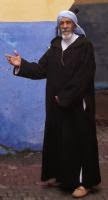
The traditional dress for men is called djellaba; a long, loose, hooded garment with full sleeves. For special occasions, men also wear a red cap called tarbouche and mostly referred to as Fez. Nearly all men wear babouches soft leather slippers with no heel, commonly in yellowbut also in many colours. Many women do as well but others wear high-heeled sandals, often in silver or gold tinsel.
The distinction is the djellabas has a hood, while a Gandora does not. The women’s djellabas are mostly of bright colors with ornate patterns, stitching, or beading, while men wear djellabas in plainer, neutral colors. Women are strongly attached to their "Moroccan wardrobe", despite the financial costs involved. The production of such garments is relatively expensive, as most of the work is done by hand. Despite the costs involved most women purchase a minimum of one new kaftan or "tk'chita" every year, normally for a special, social event, such as a religious festival or a wedding. Nowadays, it is an unwritten rule that Moroccan dress is worn at such events.For more info on Moroccan dress visit Shop Morocco






